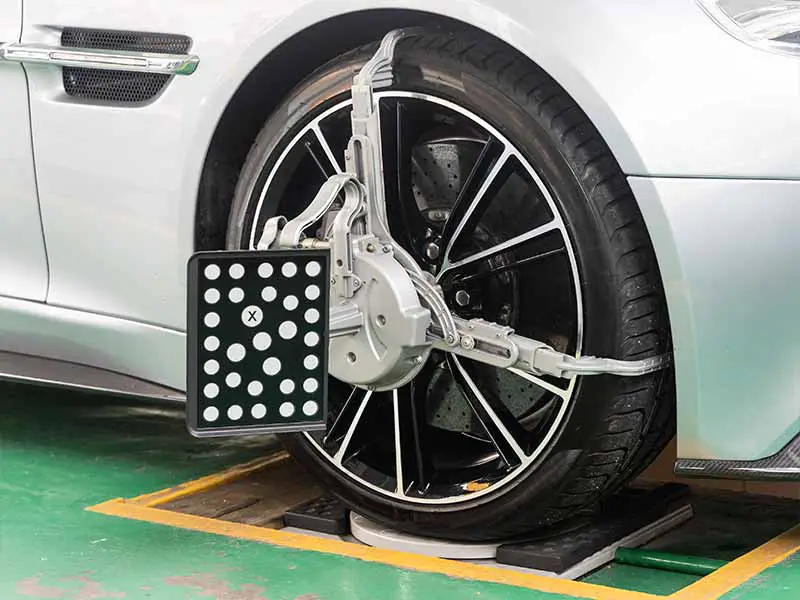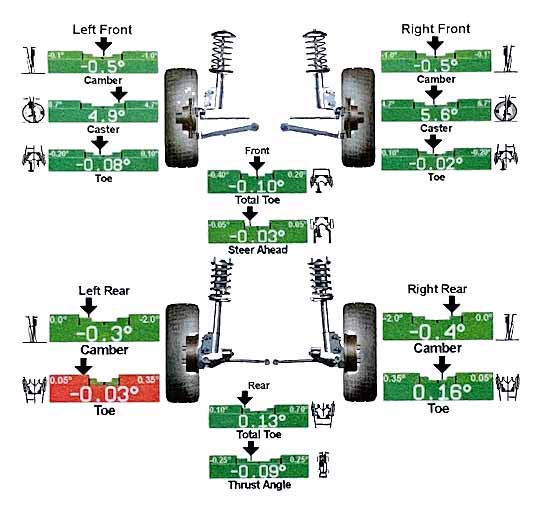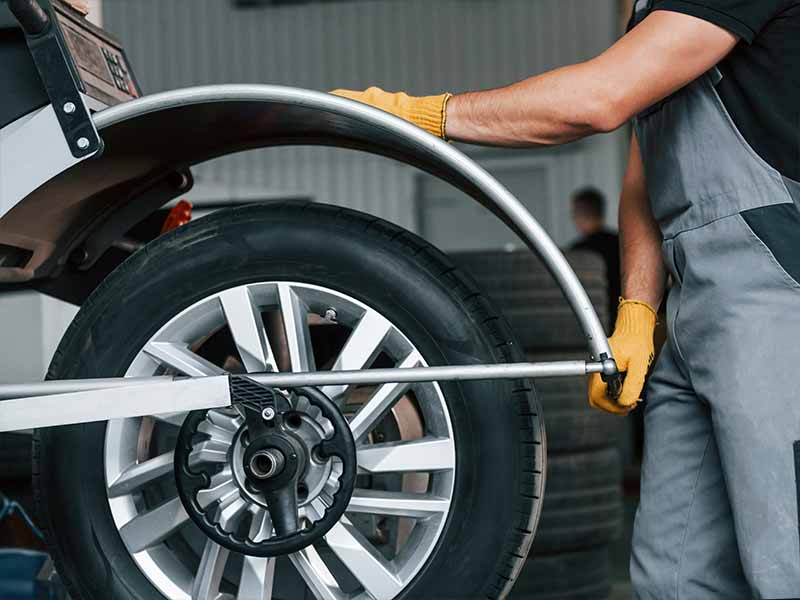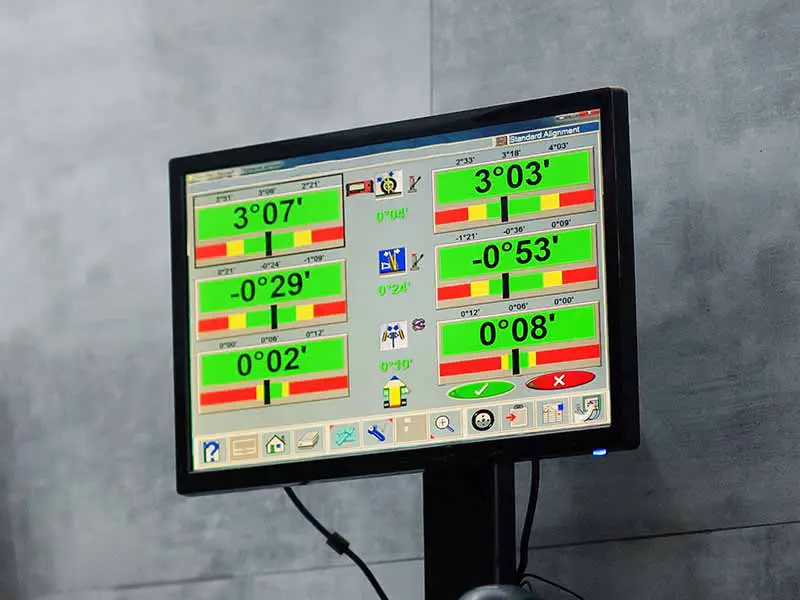Every driver knows the importance of regular maintenance. But what many don’t realize is how seemingly small aspects, like wheel or tire alignment, can impact their wallet, safety, and overall driving experience.
How Much Does Tire Alignment Cost?
The average cost of tire alignment for passenger cars and trucks typically ranges between $50 and $150. However, prices can vary based on the service provider, vehicle type, and location.
In this article, we’ll unravel the intricacies of wheel alignment, understand its importance, explore factors affecting its cost, and compare prices across popular service centers. By the end, you’ll be equipped with the knowledge to make informed decisions about your vehicle’s maintenance needs.
Let’s take a closer look.

Understanding the Basics of Tire Alignment
Wheel alignment, often referred to as wheel alignment, is an essential maintenance task to ensure your vehicle performs at its best. The following section will delve into the basics of tire alignment, its importance, and the types of alignments available.
What is Wheel Alignment?
Tire alignment refers to the adjustment of a vehicle’s suspension components. Contrary to popular belief, it’s not about adjusting the tires or wheels themselves. Instead, the wheel alignment machine is focused on the suspension system connecting your vehicle to its wheels and the vehicle manufacturer’s recommended ranges for alignment procedures.
Key Points:
- Alignments ensure the vehicle’s wheels are set to the manufacturer’s specifications.
- Proper alignment guarantees the tires are in optimal contact with the road.
- Alignments affect the position and direction in which tires point.
Types of Alignments
Different vehicles and conditions require various types of alignments. Knowing the kinds available will help you make an informed decision when servicing your vehicle.
1. Two Wheel Alignment (Front End Alignment):
- Focuses on just the front two wheels.
- Ideal for vehicles with a solid rear axle.
2. Four Wheel Alignment:
- Addresses both the front and rear wheel alignments.
- Suitable for all-wheel-drive vehicles or ones with adjustable rear suspensions.
3. Thrust Alignment:
- Ideal for cars with non-adjustable rear suspensions.
- Aligns the front wheels to the rear axle.
Why is Wheel Alignment Necessary?
Having a properly aligned vehicle is crucial for multiple reasons:
- Safety: Misaligned tires can lead to unpredictable vehicle behavior on the road, posing potential dangers.
- Tire Lifespan: Incorrect alignment often results in uneven tire wear, reducing the lifespan of the tires.
- Fuel Efficiency: A misaligned vehicle can lower gas mileage since the engine has to work harder.
- Optimal Performance: Proper alignment ensures optimal vehicle handling, giving the driver better control.

Factors Affecting Wheel Alignment Cost
Wheel alignment costs can vary significantly based on various elements. Recognizing these factors can give you a clearer picture of what to expect when you bring your vehicle in for this essential service.
Service Provider and Location
Different service providers have distinct pricing structures, influenced by several elements:
Overheads and Operating Costs:
- City-based service centers might have higher costs due to rent and other operational expenses.
Expertise and Reputation:
- Established brands or centers renowned for their service quality might charge a premium.
Regional Labor Costs:
- Labor charges differ based on geography, with urban areas generally having higher rates than rural ones.
Type of Vehicle
The vehicle type can considerably influence the alignment cost:
Passenger Cars:
- Typically, these have standard alignment needs and might cost less.
Trucks and SUVs:
- Larger vehicles might require specialized equipment or additional labor, leading to a higher price.
Luxury Vehicles:
- High-end models might have specific alignment requirements, often resulting in a premium service charge.
Alignment Machines and Technology
The machinery and technology used can also factor into the service price:
Traditional Alignment Machines:
- Older, more manual machines might have lower service charges but could take longer.
Advanced Alignment Machines:
- Modern machines, equipped with cutting-edge technology, might charge more due to precision and faster service times.
Calibration Needs:
- Some modern vehicles come with advanced driver assistance systems (ADAS) that might need recalibration post-alignment, potentially adding to the cost.

Average Costs at Popular Service Centers
One of the primary concerns for vehicle owners is the expense of wheel alignment at various service centers. While prices may vary based on location and specific vehicle needs, the following gives a general idea of costs across popular centers.
Walmart
Walmart, known for its affordability, also offers automotive services, including wheel alignments:
Pros:
- Generally more affordable than specialized auto shops.
- Convenient for those already shopping within the store.
Cons:
- Services might be limited based on the location and available equipment.
Average Price Range: Prices can vary, but a typical range might be from $50 to $80 for a standard four-wheel alignment.
Discount Tire
As a tire-focused retail chain, Discount Tire provides both sales and services:
Pros:
- Specialists in tire services, ensuring expertise.
- Often run promotions or bundled services.
Cons:
- Prices might be slightly higher than general department stores.
Average Price Range: A usual range might fall between $60 to $100, depending on the vehicle type and alignment complexity.
Firestone
With a longstanding reputation in the auto industry, Firestone offers comprehensive services:
Pros:
- Experienced technicians ensuring quality work.
- Comprehensive inspection included with alignment services.
Cons:
- Typically higher prices reflecting brand reputation and service quality.
Average Price Range: Expected costs usually range from $75 to $150, again based on the vehicle and service specifics.
Costco
While primarily a wholesale retail giant, Costco also offers tire services for its members:
Pros:
- Competitive prices especially for members.
- High-quality service backed by the Costco guarantee.
Cons:
- Must be a Costco member to avail of the services.
- Limited availability based on location.
Average Price Range: Members might find prices from $50 to $90, varying with membership tier and promotions.
Midas
A well-known brand in auto services, Midas offers a range of vehicle care:
Pros:
- Comprehensive vehicle check during alignment.
- Various service options tailored to specific needs.
Cons:
- Prices can be on the higher side, reflecting brand value.
Average Price Range: A typical alignment service might be priced between $70 and $130, contingent on vehicle specifics.
Les Schwab
Renowned for its customer service, Les Schwab provides a variety of tire services:
Pros:
- Exceptional customer service reputation.
- Comprehensive free pre-alignment checks.
Cons:
- Pricing can be premium due to the service quality offered.
Average Price Range: The price spectrum for alignments often falls between $80 and $140, based on the service details and vehicle type.

The Relationship Between Wheel Alignment and Tire Balancing
While both wheel alignment and tire balancing play a pivotal role in ensuring smooth vehicle performance and longevity, they serve distinct purposes. This section will help differentiate the two and emphasize the importance of each.
The Difference Between Alignment and Balancing
Understanding the core differences is crucial for maintaining your vehicle’s health.
Wheel Alignment:
- Focuses on adjusting the vehicle’s suspension components.
- Ensures the vehicle’s wheels are set to the manufacturer’s specifications.
- Primarily impacts the direction in which tires point and the position of the steering wheel.
Tire Balancing:
- Addresses the distribution of weight around each wheel or tire.
- Ensures smooth rides by preventing vibrations.
- Involves adding small weights to counterbalance heavy spots on the wheels.
Do You Need Both?
Both alignment and balancing cater to different aspects of vehicle maintenance, but they are interconnected in terms of providing a smooth drive.
Importance of Alignment:
- Ensures even tire wear, prolonging tire lifespan.
- Improves vehicle handling, giving the driver better control.
- Enhances fuel efficiency by ensuring optimal tire contact with the road.
Importance of Balancing:
- Prevents premature tire wear caused by unbalanced vibrations.
- Ensures a smooth and comfortable ride by avoiding shudders and shakes.
- Reduces stress on the suspension system by evenly distributing tire weight.
Key Takeaways:
- While both processes are distinct, they are complementary.
- Regularly checking both alignment and balance can save costs in the long run.
- Combining both services during routine maintenance ensures optimal vehicle performance.

How Often and Why: The Need for Regular Wheel Alignment
Ensuring your vehicle’s wheels are properly aligned is not a one-time task. It’s an ongoing maintenance necessity. Understanding how often and why you should get your tires aligned is key to ensuring your vehicle remains in optimal condition.
Signs Your Vehicle Needs Alignment
Between scheduled checks, be vigilant for indications that might suggest an alignment issue:
Steering Wheel Vibrations:
- If the steering wheel shakes or vibrates while driving, it’s often a sign that your wheels might be misaligned.
Uneven Tire Wear:
- When tires wear unevenly across their tread, it often points to alignment issues.
Steering Wheel Misalignment:
- If the steering wheel is off-center when driving straight, it’s a clear indicator.
Vehicle Drifting or Pulling:
- Should your vehicle drift to one side or require constant steering adjustments, alignment might be the culprit.
Recommended Frequency of Alignment Checks
While the frequency might vary based on vehicle type, usage, and driving conditions, here are general guidelines:
Annually:
- At the very least, aim for a yearly check, especially if the vehicle is frequently used.
After a Major Impact:
- Post an accident or hitting a large pothole, checking alignment is crucial.
When Installing New Tires:
- Whenever you get new tires, ensure they start their journey with a proper alignment.
If Signs are Present:
- Anytime you notice any of the above signs, it’s wise to get an alignment check irrespective of your last visit.
Benefits of Regular Wheel Alignment
Staying on top of alignment checks offers numerous advantages:
Safety:
- Properly aligned tires provide predictable vehicle responsiveness and handling, enhancing safety.
Economic:
- Prolonging tire lifespan by ensuring even wear can save money over time. Additionally, proper alignment aids in fuel efficiency.
Comfort:
- A smooth ride without vibrations or the need for constant steering adjustments enhances the driving experience.
Vehicle Health:
- Regular checks can help pinpoint other potential issues before they escalate, saving costly future repairs.
Resources
Below are some links you may find helpful when learning about tires
Final Thoughts
Ensuring your vehicle’s wheels are properly aligned is more than just an exercise in vehicle maintenance; it’s an investment in safety, comfort, and long-term savings. Wheel alignment cost can vary, with averages ranging from $50 to $150, influenced by factors like the service provider, vehicle type, and the alignment machinery used.
It’s important to recognize not only the signs that your vehicle needs alignment but also the critical distinction between alignment and tire balancing. Regular checks and understanding the value offered by various service centers can provide peace of mind, a smoother ride, and notable cost benefits in the long run.
Good luck and happy motoring.





